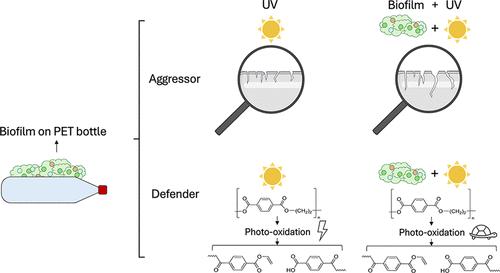塑料上的生物膜减缓光氧化,同时促进表面降解
IF 11.3
1区 环境科学与生态学
Q1 ENGINEERING, ENVIRONMENTAL
引用次数: 0
摘要
塑料在自然环境中会经历物理化学老化,但人们对生物膜──在塑料表面生长的微生物群落──的作用仍知之甚少。为了评估这一点,将聚对苯二甲酸乙二醇酯(PET)饮料瓶暴露在天然淡水中以促进生物膜的形成,随后进行紫外线照射以评估生物膜对风化的影响。结果表明,生物膜具有双重作用,既是保护者又是侵略者。当与紫外线照射相结合时,生物膜加剧了表面形态的改变,均方根粗糙度从原始PET的~ 22 nm增加到~ 874 nm,并改变了聚合物的结晶度,如拉曼光谱的位移所示。它们增加了脆性,降低了冲击强度,促进紫外线穿透更深的层并形成空腔,从而将比表面积从2g - m2(原始PET)提高到22g - m2。相比之下,紫外线单独暴露诱导广泛的光氧化,反映在更高的表面亲水性和增加的极性表面能成分。生物膜可以减弱紫外线渗透,但同时促进塑料破碎,可能通过机械弱化和结构降解间接有利于添加剂浸出。这些发现强调了自然条件下塑性风化的复杂性,这超过了在原始材料的实验室研究中观察到的动力学。本文章由计算机程序翻译,如有差异,请以英文原文为准。

Biofilms on Plastics Slow Photo-Oxidation while Promoting Surface Degradation
Plastics in natural environments undergo physicochemical aging, yet the role of biofilms─microbial communities that colonize plastic surfaces─remains poorly understood. To evaluate this, polyethylene terephthalate (PET) drinking bottles were exposed to natural freshwater to facilitate biofilm formation, and subsequently subjected to ultraviolet (UV) irradiation to assess the influence of biofilms on weathering. Results showed that biofilms exert dual roles, as both protectors and aggressors. When combined with UV exposure, biofilms intensified surface morphological alterations, root-mean-square roughness increased from ∼22 nm for pristine PET to ∼874 nm, and altered polymer crystallinity, as indicated by a shift in the Raman spectrum. They increased brittleness and reduced impact strength, facilitating UV to penetrate deeper layers and form cavities, thereby enhancing specific surface area from 2 g m–2 (pristine PET) to 22 g m–2. In contrast, UV exposure alone induced extensive photo-oxidation, reflected in higher surface hydrophilicity and increased polar surface energy components. Biofilms may attenuate UV penetration but concurrently promote plastic fragmentation, which might indirectly favor additive leaching through mechanical weakening and structural degradation. These findings underscore the complexity of plastic weathering under natural conditions, which surpasses dynamics observed in laboratory studies on pristine materials.
求助全文
通过发布文献求助,成功后即可免费获取论文全文。
去求助
来源期刊

环境科学与技术
环境科学-工程:环境
CiteScore
17.50
自引率
9.60%
发文量
12359
审稿时长
2.8 months
期刊介绍:
Environmental Science & Technology (ES&T) is a co-sponsored academic and technical magazine by the Hubei Provincial Environmental Protection Bureau and the Hubei Provincial Academy of Environmental Sciences.
Environmental Science & Technology (ES&T) holds the status of Chinese core journals, scientific papers source journals of China, Chinese Science Citation Database source journals, and Chinese Academic Journal Comprehensive Evaluation Database source journals. This publication focuses on the academic field of environmental protection, featuring articles related to environmental protection and technical advancements.
 求助内容:
求助内容: 应助结果提醒方式:
应助结果提醒方式:


